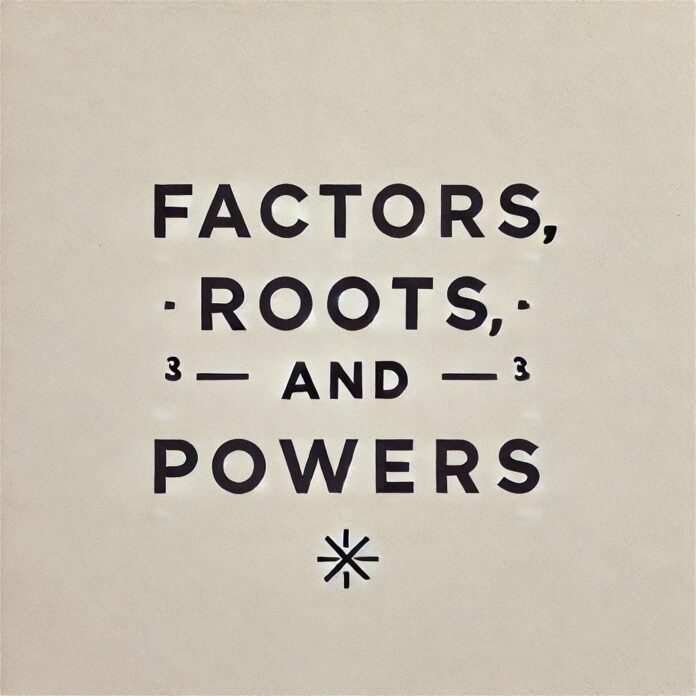Factors, roots, and powers are essential building blocks in mathematics, forming the basis for solving equations, understanding algebra, and analyzing real-world problems. These concepts appear across all areas of math, from simple arithmetic to advanced calculus, and are crucial for developing a deeper understanding of mathematical relationships.
Factors break down numbers into their building blocks, roots help reverse the process of powers, and powers allow numbers to grow exponentially. Together, these concepts provide a framework for exploring patterns, solving equations, and modeling natural phenomena.
Understanding Factors
A factor is a number that divides another number evenly, leaving no remainder. Factors are the components that multiply together to produce a given number. For example, the factors of 12 are 1, 2, 3, 4, 6, and 12 because each of these divides 12 without leaving a remainder.
Prime Factors
Prime factors are factors that are prime numbers. A prime number is a number greater than 1 that has only two factors: 1 and itself. To find the prime factors of a number, you can use a process called prime factorization.
Example: Find the prime factors of 60.
- Start by dividing the number by the smallest prime number, 2:
\(60 \div 2 = 30\) - Continue dividing by 2 until it no longer divides evenly:
\(30 \div 2 = 15\) - Move to the next smallest prime number, 3:
\(15 \div 3 = 5\) - Since 5 is a prime number, the prime factorization is:
\(60 = 2^2 \times 3 \times 5\)
Greatest Common Factor (GCF)
The GCF of two or more numbers is the largest factor they share.
Example: Find the GCF of 24 and 36.
- Factors of 24: 1, 2, 3, 4, 6, 8, 12, 24
- Factors of 36: 1, 2, 3, 4, 6, 9, 12, 18, 36
- Common factors: 1, 2, 3, 4, 6, 12
- The GCF is 12.
Roots
Roots are the inverse operation of powers. The square root of a number, for instance, is a value that, when multiplied by itself, equals the original number. Roots are denoted using the radical symbol \(\sqrt{}\).
Square Roots
The square root of \(x\) is a number \(y\) such that \(y^2 = x\). For example:
- \(\sqrt{25} = 5\) because \(5^2 = 25\).
Square roots are commonly used in geometry, physics, and algebra.
Cube Roots
The cube root of \(x\) is a number \(y\) such that \(y^3 = x\). For example:
- \(\sqrt[3]{27} = 3\) because \(3^3 = 27\).
Cube roots are particularly useful in solving volume-related problems.
Roots of Non-Perfect Numbers
When the number is not a perfect square or cube, the root may be an irrational number. For example:
- \(\sqrt{2} \approx 1.414\).
These roots are often approximated or left in radical form for exact solutions.
Applications of Roots
Roots appear in various areas of mathematics and science:
- In geometry, roots help calculate the lengths of sides in right triangles using the Pythagorean theorem.
- In physics, roots are used in equations for acceleration and energy.
- In finance, roots are involved in calculating compound interest rates.
Powers
Powers, also known as exponents, represent repeated multiplication of a number by itself. For example:
\(3^4 = 3 \times 3 \times 3 \times 3 = 81\).
The general form is:
\(a^n\), where:
- \(a\) is the base.
- \(n\) is the exponent.
Properties of Powers
Powers have several important properties that simplify calculations:
- Product Rule: Multiply powers with the same base by adding exponents.
\(a^m \times a^n = a^{m+n}\)
Example: \(2^3 \times 2^4 = 2^{3+4} = 2^7\). - Quotient Rule: Divide powers with the same base by subtracting exponents.
\(a^m \div a^n = a^{m-n}\)
Example: \(5^6 \div 5^2 = 5^{6-2} = 5^4\). - Power of a Power: Multiply the exponents.
\(^n = a^{m \times n}\)
Example: \(^3 = 3^{2 \times 3} = 3^6\). - Power of a Product: Apply the exponent to each factor.
\(^n = a^n \times b^n\)
Example: \((2 \times 3)^2 = 2^2 \times 3^2 = 4 \times 9 = 36\). - Power of a Quotient: Apply the exponent to the numerator and denominator.
\(\left(\frac{a}{b}\right)^n = \frac{a^n}{b^n}\)
Example: \(\left(\frac{2}{3}\right)^2 = \frac{2^2}{3^2} = \frac{4}{9}\). - Zero Exponent: Any base raised to the power of 0 is 1.
\(a^0 = 1\) (where \(a \neq 0\)). - Negative Exponent: A negative exponent represents the reciprocal.
\(a^{-n} = \frac{1}{a^n}\)
Example: \(2^{-3} = \frac{1}{2^3} = \frac{1}{8}\).
Applications of Powers
Powers are used in various areas, including:
- Calculating large numbers in astronomy and physics.
- Expressing growth rates in biology and finance.
- Simplifying mathematical models in engineering.
Relationships Between Factors, Roots, and Powers
Factors, roots, and powers are interconnected concepts. For example:
- Finding the square root of a number is the reverse operation of squaring it.
- Prime factorization can simplify finding roots or evaluating powers.
- Powers can create large numbers, while roots and factors help break them down.
Real-World Examples
- Geometry: To find the diagonal of a square with sides of 5 units, use the Pythagorean theorem:
\(d = \sqrt{5^2 + 5^2} = \sqrt{50} = 5\sqrt{2}\). - Physics: In equations like \(E = mc^2\), the square of the speed of light (\(c\)) illustrates the relationship between energy (\(E\)) and mass (\(m\)).
- Finance: Compound interest involves powers in the formula:
\(A = P(1 + r)^n\), where \(P\) is the principal, \(r\) is the rate, and \(n\) is the number of periods.
Factors, roots, and powers are indispensable tools in mathematics, providing a foundation for solving equations and understanding complex systems. These concepts enable us to break down problems, reverse operations, and model exponential growth or decay. Mastering these principles enhances problem-solving skills and paves the way for deeper exploration into algebra and beyond.

